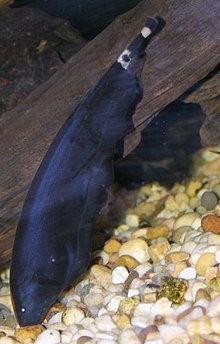Apteronotus is a genus of weakly electric knifefish in the family Apteronotidae, distinguished by the presence of a tiny tail fin. This genus is restricted to tropical and subtropical South America (Amazon, Orinoco, Río de la Plata and Magdalena basins, as well as rivers in western Colombia and the Guianas) and Panama where found in a wide range of freshwater habitats.[1][2] They feed on small animals.[1]
| Apteronotus | |
|---|---|

| |
| Black ghost knifefish (A. albifrons) | |
| Scientific classification | |
| Domain: | Eukaryota |
| Kingdom: | Animalia |
| Phylum: | Chordata |
| Class: | Actinopterygii |
| Order: | Gymnotiformes |
| Family: | Apteronotidae |
| Genus: | Apteronotus Lacépède, 1800 |
| Type species | |
| Gymnotus albifrons Linnaeus, 1766
| |
Depending on the exact species, they reach a total length of up to about 18–50 cm (7–20 in). Although it has been claimed that A. magdalenensis is up to 130 cm (4.3 ft) long, this is not supported by recent studies and likely the result of confusion with Sternopygus aequilabiatus.[1][3] Members of Apteronotus fall into three species groups based on their morphology: the A. albifrons group have a rounded snout and are black or dark brown with a contrasting light stripe on the top of the head, and bands on the tail and at its base, the A. leptorhynchus group have an elongate, slender snout (especially in males) and are brown with a light stripe along the head and back, and a band on the tail, and the A. bonapartii group have an elongate (males) or rounded (females) snout and are brown or gray (capable of some color change) with a light band on the tail.[1] The last group is not closely related to the first two and will likely need to be moved to another genus.[2][4] A genetic study published in 2019 found that the genus is strongly polyphyletic with several groups that are quite distantly related.[5]
Species
editThere are currently 27 recognized species in this genus:[6][7][8]
- Apteronotus acidops Triques, 2011[9]
- Apteronotus albifrons (Linnaeus, 1766) (Black ghost knifefish)
- Apteronotus anu de Santana & Vari, 2013[8]
- Apteronotus apurensis Fernández-Yépez, 1968
- Apteronotus baniwa de Santana & Vari, 2013[8]
- Apteronotus bonapartii (Castelnau, 1855)
- Apteronotus brasiliensis (J. T. Reinhardt, 1852)
- Apteronotus camposdapazi de Santana & Lehmann-A., 2006
- Apteronotus caudimaculosus de Santana, 2003
- Apteronotus cuchillejo (L. P. Schultz, 1949)
- Apteronotus cuchillo L. P. Schultz, 1949
- Apteronotus ellisi (Alonso de Arámburu, 1957)
- Apteronotus eschmeyeri de Santana, Maldenado-Ocampo, Severi & G. N. Mendes, 2004
- Apteronotus ferrarisi de Santana & Vari, 2013[8]
- Apteronotus galvisi de Santana, Maldenado-Ocampo & Crampton, 2007
- Apteronotus jurubidae (Fowler, 1944)
- Apteronotus leptorhynchus (M. M. Ellis, 1912) (Brown ghost knifefish)
- Apteronotus lindalvae de Santana & Cox Fernandes, 2012[7]
- Apteronotus macrolepis (Steindachner, 1881)
- Apteronotus macrostomus (Fowler, 1943)
- Apteronotus magdalenensis (Miles, 1945)
- Apteronotus magoi de Santana, Castillo G. & Taphorn, 2006
- Apteronotus mariae (C. H. Eigenmann & Fisher, 1914)
- Apteronotus milesi de Santana & Maldenado-Ocampo, 2005
- Apteronotus pemon de Santana & Vari, 2013[8]
- Apteronotus rostratus (Meek & Hildebrand, 1913)
- Apteronotus spurrellii (Regan, 1914)
References
edit- ^ a b c d van der Sleen, P.; J.S. Albert, eds. (2017). Field Guide to the Fishes of the Amazon, Orinoco, and Guianas. Princeton University Press. pp. 322–326. ISBN 978-0691170749.
- ^ a b Ferraris Jr, C.J.; C.D. de Santana; R.P. Vari (2017). "Checklist of Gymnotiformes (Osteichthyes: Ostariophysi) and catalogue of primary types". Neotrop. Ichthyol. 15 (1). doi:10.1590/1982-0224-20160067.
- ^ Maldonado-Ocampo, J.A.; Santana, C.D. de; W.G.R. Crampton (2011). "On Apteronotus magdalenensis (Miles, 1945) (Gymnotiformes: Apteronotidae): a poorly known species endemic to the río Magdalena basin, Colombia". Neotrop. Ichthyol. 9 (3): 505–514. doi:10.1590/S1679-62252011000300005.
- ^ Hilton, E.J.; C.C. Fernandes (2017). "Identity of "Apteronotus" bonapartii (Castelnau, 1855), a sexually dimorphic South American knifefish from the Amazon, with notes on its cranial osteology and on the taxonomic status of "Apteronotus" apurensis Fernández-Yépez, 1968 (Gymnotiformes, Apteronotidae)". Proceedings of the Academy of Natural Sciences of Philadelphia. 165: 91–103. doi:10.1635/053.165.0109.
- ^ Bernt, M.J.; V.A. Tagliacollo; J.S. Albert (2019). "Molecular Phylogeny of the Ghost Knifefishes (Gymnotiformes: Apteronotidae)". Molecular Phylogenetics and Evolution. 135: 297–307. doi:10.1016/j.ympev.2019.02.019.
- ^ Froese, Rainer; Pauly, Daniel (eds.). "Species in genus Apteronotus". FishBase. April 2013 version.
- ^ a b de Santana, C.D. & Cox Fernandes, C. (2012): A New Species of Sexually Dimorphic Electric Knifefish from the Amazon Basin, Brazil (Gymnotiformes: Apteronotidae). Copeia, 2012 (2): 283-292.
- ^ a b c d e de Santana, C.D. & Vari, R.P. (2013): Brown ghost electric fishes of the Apteronotus leptorhynchus species-group (Ostariophysi, Gymnotiformes); monophyly, major clades, and revision. Zoological Journal of the Linnean Society, 168 (3): 564–596.
- ^ Triques, M.L. (2011): Apteronotus acidops, new species of long snouted electric fish (Teleostei: Gymnotiformes: Apteronotidae) from the upper rio Paraná basin in Brazil, with a key to the apteronotid species from the area. Vertebrate Zoology, 61 (3): 299–306.